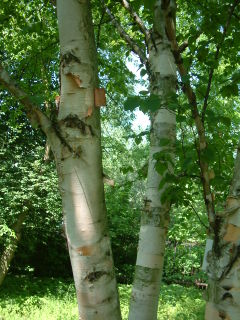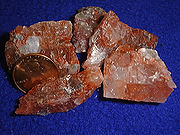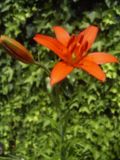
Symbols of Saskatchewan
Encyclopedia

Canada
Canada is a North American country consisting of ten provinces and three territories. Located in the northern part of the continent, it extends from the Atlantic Ocean in the east to the Pacific Ocean in the west, and northward into the Arctic Ocean...
's provinces
Provinces and territories of Canada
The provinces and territories of Canada combine to make up the world's second-largest country by area. There are ten provinces and three territories...
, and has established several provincial symbols.
Symbols
| Symbol | Image | Adopted | Remarks | |
|---|---|---|---|---|
| Coat of arms Coat of arms A coat of arms is a unique heraldic design on a shield or escutcheon or on a surcoat or tabard used to cover and protect armour and to identify the wearer. Thus the term is often stated as "coat-armour", because it was anciently displayed on the front of a coat of cloth... |
Coat of Arms of Saskatchewan Coat of arms of Saskatchewan The first part of the Coat of Arms of the Province of Saskatchewan , was the shield, which was assigned by royal warrant of King Edward VII on 25 August 1906. It uses the provincial colours, green and gold.On the gold chief is a lion passant or leopard, a royal symbol of England... |
September 16, 1986 | Coat of arms granted by royal proclamation of Queen Elizabeth II | |
| Motto Motto A motto is a phrase meant to formally summarize the general motivation or intention of a social group or organization. A motto may be in any language, but Latin is the most used. The local language is usual in the mottoes of governments... |
Multis e gentibus vires From many peoples, strength |
1986 | Granted with the coat of arms by royal proclamation of Queen Elizabeth II | |
| Shield of arms | Shield of Saskatchewan | August 25, 1906 | Shield of arms granted by the Royal Warrant of King Edward VII | |
| Provincial symbol | Saskatchewan's Wheat Sheaf | 1977 | Used to identify government programs and organizations | |
| Flag Flag A flag is a piece of fabric with a distinctive design that is usually rectangular and used as a symbol, as a signaling device, or decoration. The term flag is also used to refer to the graphic design employed by a flag, or to its depiction in another medium.The first flags were used to assist... |
Flag of Saskatchewan Flag of Saskatchewan The flag of Saskatchewan features the armorial bearings in the upper quarter nearest the staff, with the floral emblem, the western red lily, in the fly. The upper green half of the flag represents the northern Saskatchewan forest lands, while the gold lower half symbolizes the southern, prairie... |
 |
1969 | Green for northern forests, gold for southern grain fields |
| The Great Seal | The Great Seal of Saskatchewan | May 7, 1991 | First Great Seal of Saskatchewan granted by royal warrant of King Edward VII on August 25, 1906, The Great Seal of Saskatchewan of 1991 was authorized by an Order-in-Council. | |
| Bird Bird Birds are feathered, winged, bipedal, endothermic , egg-laying, vertebrate animals. Around 10,000 living species and 188 families makes them the most speciose class of tetrapod vertebrates. They inhabit ecosystems across the globe, from the Arctic to the Antarctic. Extant birds range in size from... |
Sharp-tailed Grouse Sharp-tailed Grouse The Sharp-tailed Grouse, Tympanuchus phasianellus , is a medium-sized prairie grouse. It is also known as the sharptail, and is known as "fire grouse" or "fire bird" by Native American Indians due to their reliance on brush fires to keep their habitat open.-Taxonomy:The Greater Prairie-chicken,... Pedioectes phasianellus jamesi |
 |
1945 | The Sharp-tailed Grouse lives year-round in Saskatchewan |
| Tree Tree A tree is a perennial woody plant. It is most often defined as a woody plant that has many secondary branches supported clear of the ground on a single main stem or trunk with clear apical dominance. A minimum height specification at maturity is cited by some authors, varying from 3 m to... |
Paper Birch Paper Birch Betula papyrifera is a species of birch native to northern North America.-Description:... Betula papyrifera |
 |
1988 | Used as firewood, for plywood, and for construction of canoes |
| Mineral Mineral A mineral is a naturally occurring solid chemical substance formed through biogeochemical processes, having characteristic chemical composition, highly ordered atomic structure, and specific physical properties. By comparison, a rock is an aggregate of minerals and/or mineraloids and does not... |
Potash Potash Potash is the common name for various mined and manufactured salts that contain potassium in water-soluble form. In some rare cases, potash can be formed with traces of organic materials such as plant remains, and this was the major historical source for it before the industrial era... |
 |
February 1996 | Was given official status by amendments to The Provincial Emblems and Honours Act in May 1997 |
| Animal Animal Animals are a major group of multicellular, eukaryotic organisms of the kingdom Animalia or Metazoa. Their body plan eventually becomes fixed as they develop, although some undergo a process of metamorphosis later on in their life. Most animals are motile, meaning they can move spontaneously and... |
White-tailed deer White-tailed Deer The white-tailed deer , also known as the Virginia deer or simply as the whitetail, is a medium-sized deer native to the United States , Canada, Mexico, Central America, and South America as far south as Peru... Odocoileus virginianus |
2001 | First appeared in Saskatchewan coat of arms in 1986 | |
| Flower Flower A flower, sometimes known as a bloom or blossom, is the reproductive structure found in flowering plants . The biological function of a flower is to effect reproduction, usually by providing a mechanism for the union of sperm with eggs... |
Western red lily Lilium Lilium is a genus of herbaceous flowering plants growing from bulbs. Most species are native to the temperate northern hemisphere, though the range extends into the northern subtropics... Lilium philadelphicum var. andinum |
 |
1941 | It is a protected species. |
| Grass Grass Grasses, or more technically graminoids, are monocotyledonous, usually herbaceous plants with narrow leaves growing from the base. They include the "true grasses", of the Poaceae family, as well as the sedges and the rushes . The true grasses include cereals, bamboo and the grasses of lawns ... |
Needle-and-thread grass Stipoideae Stipoideae is the name of a subfamily of the true grass family Poaceae. It is not recognised by most botanists.... Hesperostipa comata |
2001 | It was selected by a coalition of environmental, wildlife and agricultural organizations. | |
| Sport Sport A Sport is all forms of physical activity which, through casual or organised participation, aim to use, maintain or improve physical fitness and provide entertainment to participants. Sport may be competitive, where a winner or winners can be identified by objective means, and may require a degree... |
Curling Curling Curling is a sport in which players slide stones across a sheet of ice towards a target area. It is related to bowls, boule and shuffleboard. Two teams, each of four players, take turns sliding heavy, polished granite stones, also called "rocks", across the ice curling sheet towards the house, a... |
 |
2001 | In Saskatchewan since the 1880s |
| Tartan Tartan Tartan is a pattern consisting of criss-crossed horizontal and vertical bands in multiple colours. Tartans originated in woven wool, but now they are made in many other materials. Tartan is particularly associated with Scotland. Scottish kilts almost always have tartan patterns... |
Gold, brown, green, red, yellow, white and black. | 1961 | The provincial tartan was registered with the Court of Lord Lyon King of Arms in Scotland. | |
| Dress Tartan of Saskatchewan | The original provincial tartan, with the off-white line becoming the background colour of the dress version. | 1997 | Saskatchewan dress tartan was introduced for competitive highland dancers on the occasion of the Canadian Interprovincial Highland Dancing Championships. | |

